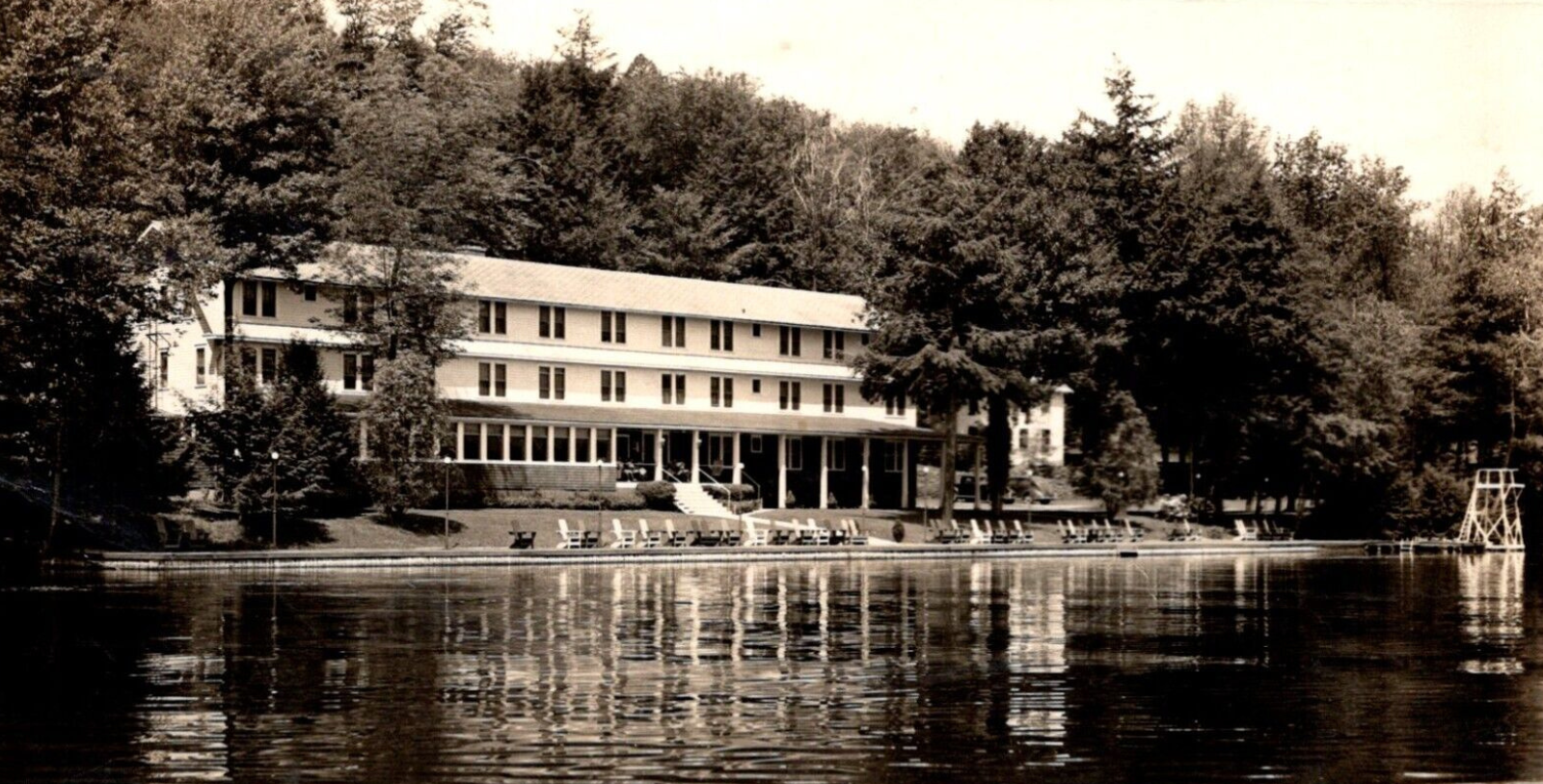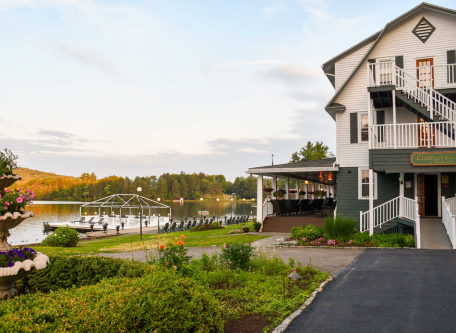Receive for Free - Discover & Explore eNewsletter monthly with advance notice of special offers, packages, and insider savings from 10% - 30% off Best Available Rates at selected hotels.
the chestnut inn history
Discover The Chestnut Inn, which has been a renowned local landmark within the foothills of the Catskills for close to a century.
The Chestnut Inn, a member of Historic Hotels of America since 2023, dates back to 1927.
VIEW TIMELINEAt the height of the American Gilded Age, the Catskills rapidly emerged as one of the country’s most visited holiday destinations, largely because its tranquil, verdant landscape is near major urban centers like New York City and Philadelphia, enabling countless families to escape the intensity of city life for a long, peaceful weekend. Among the most popular areas in the region to see widespread visitation were its western foothills, including the remote shoreline of Oquaga Lake. Dozens of quaint cottages gradually lined the lake’s sloping terrain, nestled comfortably within the thick vegetation surrounding it. Among the numerous dwellings to debut near Oquaga Lake was a brilliant home referred to as the “Monoquaga,” which had been owned by the Knapp family starting in the 1870s. Like many of their neighbors, the Knapps would spend several decades vacationing in the area until their descendants sold the land to Samuel Retzer during the Roaring Twenties.
Retzer was a prosperous businessperson from southern New York who had recently sold his majority interest in a lucrative express company. Falling in love with Lake Oquaga, Retzer ultimately decided to use the location of the erstwhile Knapp family cabin to host a prospective new hotel. Construction commenced in 1927 and lasted for an entire year. Sparing no expense, Retzer developed a beautifully rustic lakeside facility over the next few months. The artisans assigned to the project took great care when constructing the building, painstakingly installing a wonderful dining space, a sprawling, 100-foot-long porch, and a massive fireplace just beyond the front door. Perhaps the most remarkable architectural trait the building possessed was its resplendent woodworking, crafted from American chestnut. When the new “Hotel Monoquaga” finally opened in 1928, it quickly established a reputation for its excellent service and rich character. Generations of families habitually booked guestrooms at the building over the following decades, too, becoming incredibly popular by the beginning of the 1950s.
Its success was thanks to the diligent efforts of Samuel Retzer and his wife, Elizabeth, who continued to guide the magnificent Catskill Mountains hotel throughout. However, business started to decline toward the end of the 1970s, leading to the hotel’s eventual closure in 1989. Facing an uncertain fate, Bill and David Maines then purchased the historic hotel in the early 1990s, renaming it as “The Chestnut Inn.” They also instituted a thorough renovation of the compound, which brilliantly revitalized its fantastic character. More recently, in 2023, Settlers Hospitality acquired the historic site and instituted its own extensive restoration. The Chestnut Inn now proudly offers 17 terrific guestrooms, of which most face the calm waters of Lake Oquaga. Indeed, the future of this fascinating historic New York hotel has never looked brighter.
-
About the Location +
Straddling the border between Broome and Delaware counties, the municipality of Deposit is a quaint country hamlet rich in pastoral character. But this tranquil town is also located within the western foothills of the majestic Catskills Mountain Range—one of New York’s most renowned natural landmarks. Extending for some 5,800 square miles, the Catskills are celebrated for their wealth of stunning geological features and distinctive wildlife. In fact, the mountain system contains more than 30 peaks that measure well above 3,500 feet in height, as well as hundreds of acres of extensive forest. (The Catskills are also a part of the much larger Appalachian Mountains, with geologists considering them one of its physiological provinces.) However, the Catskills also possess a fascinating history that harkens back millennia. Indeed, archeological evidence has uncovered that various Native American tribes once inhabited the region for generations, notably the Lenape and Mohicans. While modern scholars remain uncertain about the extent of their settlements, it is clear that a collection of small villages dotted the landscape periodically. But widespread habitation was scant, leaving the Catskills largely unpopulated when the first European settlers—the Dutch—began settling the region during the 17th century.
Even then, the Catskills were mostly avoided, with the Dutch colonists choosing to occupy the neighboring Hudson Valley. However, limited exploration of the Catskills did commence, as some small groups of pioneers founded a couple of towns toward the eastern end of the range in present-day Ulster County. The colonial Dutch were even responsible for giving the mountains their name, although the exact inspiration for the term “Catskills” has since remained a mystery. Nevertheless, the region’s settlement finally gained momentum when New York was a British colony in the 18th century. At first, the colonial government in New York had deeded most of the land to Sir Johannes Hardenbergh, which hampered the ability of ordinary farmers to move into the Catskills. However, the process increased exponentially once Hardenbergh’s estate was subdivided by British authorities upon his death in 1745. The Livingston family, in particular, helped spur the development of the Catskills afterward, recognizing the area’s potential for logging and other economic enterprises. By the time of the American Revolution, the Catskills had thus come to feature the interlocking network of quaint farms and bucolic villages that define its landscape today.
Much of the region’s fauna and flora were untouched, too, giving the Catskills a serene environment that many people found enchanting. Perhaps the most outstanding example of this admiration was the numerous paintings of the mountains renowned artists like Thomas Cole had created during the mid-19th century. The picturesque ambiance of the Catskills also inspired some travelers to seek out vacation experiences within them, particularly at the onset of the Gilded Age. Jewish Americans especially came to adore the Catskills, seeing it as a terrific location to establish their own retreats free from the discrimination that they experienced elsewhere in the Northeastern United States. Their patronage eventually led to the proliferation of a few hundred resort complexes throughout the Catskills, which were incredibly successful for decades. Several of the most prominent retreats even became top destinations for live entertainment during the 20th century, especially standup comedy. Although many of those hotels are no longer open today, the Catskills have nonetheless endured as a top vacation hotspot, particularly for contemporary outdoor enthusiasts, as the region’s verdant geography is an ideal host for activities like hiking and skiing. Among the best places to experience the natural beauty of the mountain range is the lush Catskill Park, a massive forest preserve that has enchanted thousands of visitors since its debut in 1885.
-
About the Architecture +
Originally constructed at the height of the Roaring Twenties, The Chestnut Inn displays a distinctive architectural style known as “American Craftsman.” The form itself was a byproduct of the more widely known Arts and Crafts movement, which was conceived by English reformers earlier during the Victorian era. Among its most prolific founders was architect William Morris, who had found the urban sprawl of the Industrial Revolution to be distasteful. Yearning to find a solution, Morris and his colleagues suggested inventing new artistic philosophies that drew inspiration from preindustrial societies. As Morris expressed, the new style would focus more on the handcrafted quality rather than the mass-produced tastes of industrialization. Furthermore, Morris envisioned this new rustic aesthetic to serve ordinary families, as the building materials and floorplans would emphasize a pleasant mixture of utility and simplicity. Those ideals greatly affected British society, which developed a host of new goods that embraced rusticity. In fact, the philosophy became so popular that it had found a ready audience in North America by the beginning of the 20th century. Indeed, numerous architects reinterpreted the aesthetic across the United States, giving birth to a unique architectural offshoot known as “American Craftsman.” (Historians often credit Gustav Stickley for popularizing the aesthetic, having published several articles celebrating its qualities within issues of his trade publication, The Craftsman.)
Practitioners of the American Craftsman style subsequently designed structures that used natural wood, brick, or stone in a manner similar to Tudor-era architecture. Low-pitched roofs hung from the top of the buildings, while a gorgeous porch usually wrapped around the front façade. Inside, the layout rejected conventional Victorian design practices by being open and inviting. The American architects also encouraged the development of built-in furniture and light fixtures, which ensured a beautiful marriage of accessibility and creativity. A massive fireplace even anchored the main living room, designed to emphasize the importance of family comfort within the home. Although the exact appearance of the aforementioned designs differed slightly based on region, the American Craftsman style produced a new kind of structure called the “bungalow.” Homes and small businesses served as the primary type of “bungalow” designed using American Craftsman motifs, although a few churches and municipal buildings used the style, too. The rustic nature of American Craftsman architecture even moved the nascent National Park Service to develop its own exclusive architectural theme for all the inns and lodges it planned to open at the time! Nevertheless, interest in American Craftsman architecture gradually waned in the years leading up to World War II before losing momentum entirely around the start of the Cold War. However, its influence still endured, functioning as a foundation for future architectural styles like Frank Llyod Wright’s celebrated Prairie School.
-
Famous Historic Guests +
Jimmy Walker, Mayor of New York City (1926 – 1932)
Al Smith, 42nd Governor of New York (1923 – 1928)

































